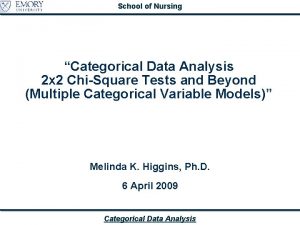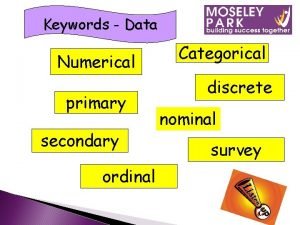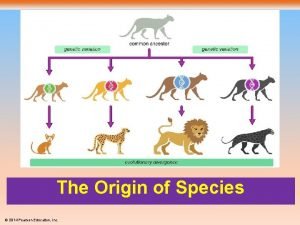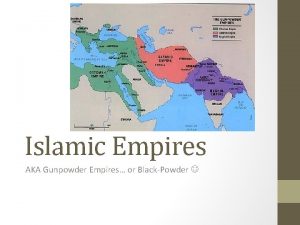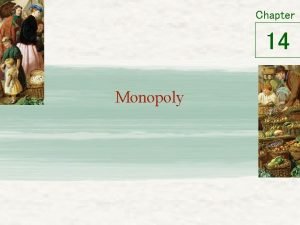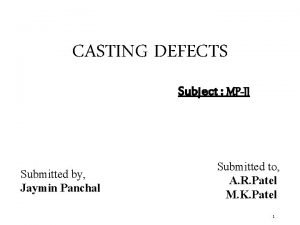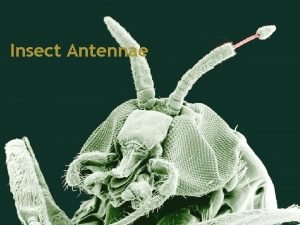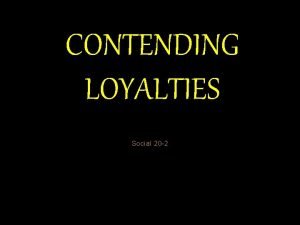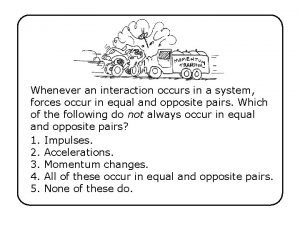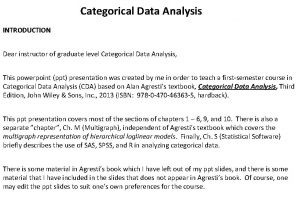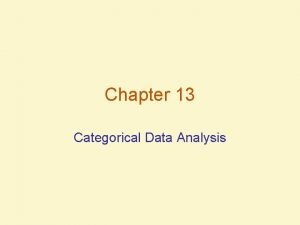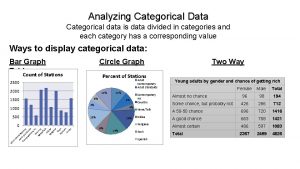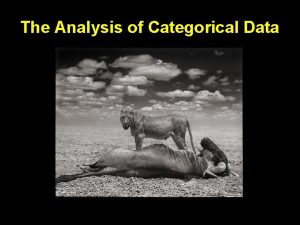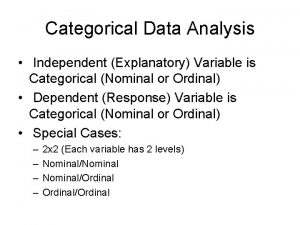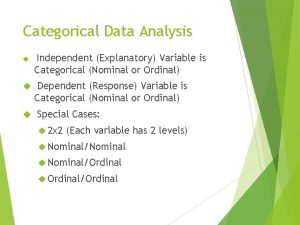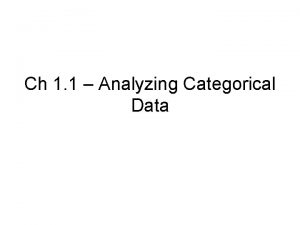Categorical Data Analysis Categorical data arise whenever counts




















- Slides: 20

Categorical Data Analysis

Categorical data arise whenever counts (as opposed to measurements) are made. Subjects (sample items) are classified as belonging to one of a set of categories and the numbers in the categories (the frequencies) are recorded.

Example Eye colours: eye colours of males visiting an optician, in four categories Colour Frequency observed A 89 B 66 C D 60 85

Example Tonsils: Relationship between nasal carrier status for Streptococcus pyogenes and size of tonsils among 1398 children aged 0 -15 years. Normal Enlarg Much Total ed enlarged Carriers 19 29 24 72 Noncarriers 497 560 269 1326 516 589 293 1398 Total

Example Prussian cavalry deaths: numbers of cavalry soldiers killed by horsekicks in each of 14 units of the Prussian army over a 20 -year period (1875 -1894). Number killed Frequency observed 0 1 2 3 4 5 Total 144 91 32 11 2 0 280

Often we wish to decide whether the categorical variables follow some well known distribution A chi-squared test will provide a method of testing the hypothesis that a data set follows a particular distribution.

Often we wish to decide whether the categorical variables follow some well known distribution A chi-squared test will provide a method of testing the hypothesis that a data set follows a particular distribution. It works by summing the quantity (Observed – Expected)2/Expected

The chi-squared test in the R program is fairly limited – it copes well with testing whethere is a significant relationship between nasal carrier status for Streptococcus pyogenes and size of tonsils among 1398 children aged 0 -15 years (as in the second example) but gives us a problem with the other two.

Consider now data from Standard and Poor’s 500 - an index of 500 of the largest, most actively traded stocks on the New York Stock Exchange These data are available in R as sp 500. R from the module website.


Technique: To look at any one of the variables in a data frame such as sp. 500, the $ sign is helpful. Without attaching the data, typing “adjclose” produces nothing.

Instead use >sp 500$adjclose or >plot(sp 500$adjclose)


We are interested in the distribution of the change in returns from day to day. We suspect that the logs of these changes may follow a normal distribution.

These are placed in an R vector by using the command >d=diff(log(sp 500$adjclose))


The chisq function that is pre-defined in R is not powerful enough to test the values of d to see if they conform to a normal distribution, so a program is written instead.

We wish to test whether a normal distribution with the same mean and standard deviation of d will look similar to this histogram. Calculate, for example, the approximate expected number between -0. 04 and -0. 02 by

This can be repeated and made more sophisticated with more than 4 comparisons by writing a program. The one considered has 100 comparisons.

 Genderx nurse
Genderx nurse Secondary keywords
Secondary keywords Describe the conditions under which new species may arise.
Describe the conditions under which new species may arise. How to arise and shine
How to arise and shine How did the ottoman safavid and mughal empires arise
How did the ottoman safavid and mughal empires arise How does monopoly arise?
How does monopoly arise? Verbs infinitive past simple and past participle
Verbs infinitive past simple and past participle Why do territorial conflicts arise among religious groups
Why do territorial conflicts arise among religious groups Why might fishing disputes arise in the region
Why might fishing disputes arise in the region Oh church arise
Oh church arise 在这美丽的时刻
在这美丽的时刻 Arise precision casting
Arise precision casting Wb yeats innisfree
Wb yeats innisfree Aristate antennae
Aristate antennae Arise to greet the lord of light
Arise to greet the lord of light Arise due to
Arise due to Padi quiz 3 answers
Padi quiz 3 answers Contending loyalties examples
Contending loyalties examples Conflict occurs whenever
Conflict occurs whenever Whenever the weather is cold
Whenever the weather is cold Whenever an interaction occurs in a system
Whenever an interaction occurs in a system
